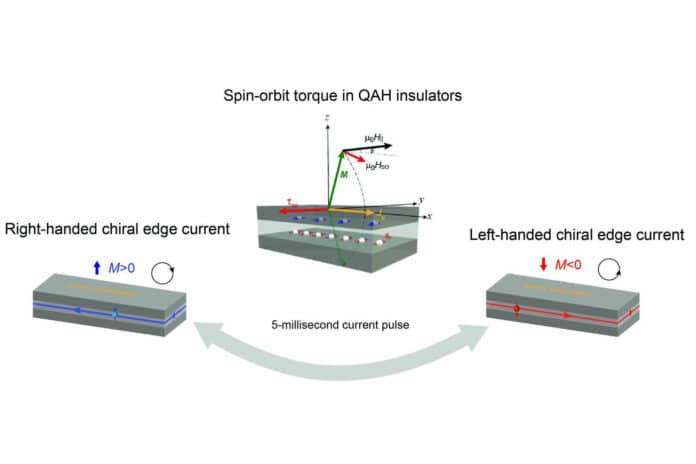In a quantum anomalous Hall (QAH) insulator, the interior is insulating, but electrical current flows along the edges of the sample in either a clockwise or counterclockwise direction. The spontaneous magnetization orientation directs this flow. Such a chiral edge current eliminates any backscattering, giving rise to quantized Hall resistance and zero longitudinal resistance.
A team of researchers from Penn State developed and demonstrated a new electrical method to change the direction of electron flow in some quantum materials. This method, shown in materials that exhibit the quantum anomalous Hall (QAH) effect, could pave the way for developing next-generation electronic devices and quantum computers.
Cui-Zu Chang, Henry W. Knerr, Early Career Professor and associate professor of physics at Penn State and co-corresponding author of the paper, said, “The QAH effect is promising because there is no energy loss as electrons flow along the edges of materials. Because the electrons travel cleanly in one direction, the effect is called dissipationless, meaning no energy is lost in heat.”
Previously, scientists have demonstrated how to scale up the QAH effect, essentially creating a multilane highway for faster electron transport. In this study, they design a new electrical technique to manage the electron highway’s travel direction and offer a way for those electrons to do a U-turn immediately.
Scientists created a QAH insulator with specific, optimized properties. When they applied a 5-millisecond current pulse to the QAH insulator, the insulator started impacting the internal magnetism of the material and caused the electrons to change directions.
The capacity to shift direction is essential to maximize information transit, storage, and retrieval in quantum technologies. Quantum data can be simultaneously stored in various potential states, unlike existing electronics, which keep data in a binary form as on or off—as one or zero. Altering the electron flow is an essential step in writing and reading these quantum states.
Chao-Xing Liu, professor of physics at Penn State and co-corresponding author of the paper, said, “The previous method to switch the direction of electron flow relied on an external magnet to alter the material’s magnetism, but using magnets in electronic devices is not ideal. Bulky magnets are impractical for small devices like smartphones, and an electronic switch is typically much faster than a magnetic one. In this work, we found a convenient electronic method to change the direction of electron flow.”
“To make this method effective, we needed to increase the density of the applied current. By narrowing the QAH insulator devices, the current pulse resulted in very high current density that switched the magnetization direction and the direction of the electron transport route.”
The researchers claim that this change in quantum materials from magnetic to electrical control is comparable to a change in conventional memory storage: Newer “flash memory,” such as that used in USB drives, solid-state hard drives, and smartphones, is written electronically. Older “flash memory” utilized magnets to create a magnetic field and write data. Similarly, promising new memory scaling technologies like MRAM rely on internal magnetic processes.
The research team also offered a theoretical interpretation of their methods and practical evidence.
To turn the system on and off effectively, the team is investigating how to pause electrons as they progress. Additionally, they are looking into how to show the QAH effect at higher temperatures.
Journal Reference:
- Yuan, W., Zhou, LJ., Yang, K. et al. Electrical switching of the edge current chirality in quantum anomalous Hall insulators. Nat. Mater. (2023). DOI: 10.1038/s41563-023-01694-y
